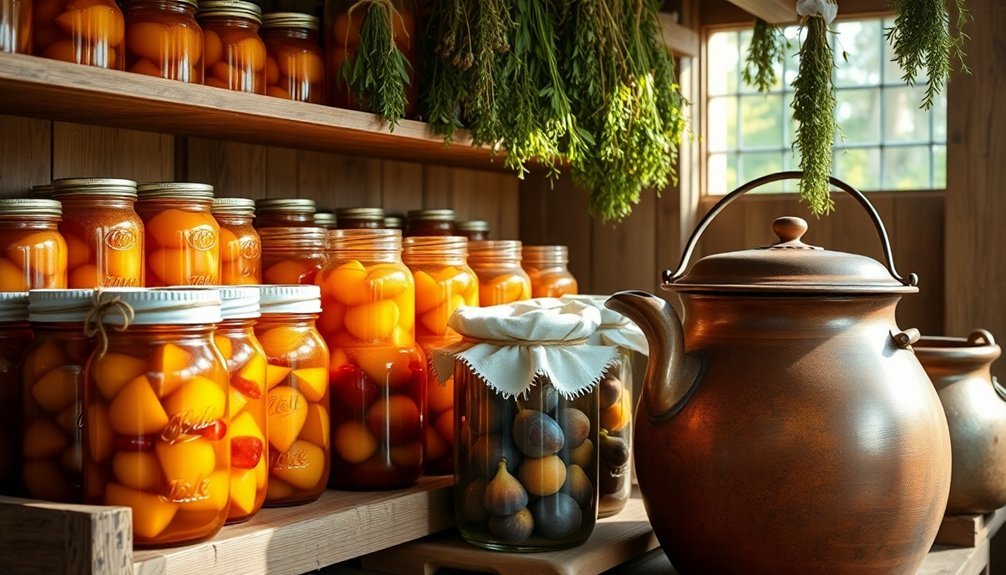Three sweet preservation methods have endured through centuries of culinary tradition. You'll find sugaring, where sugar draws moisture from fruits through osmosis, creating an environment hostile to bacteria while producing delicious candied treats. You can also preserve fruits through sweet pickling, a technique dating back to ancient Mesopotamia that combines sugar with vinegar or brine. Traditional fermentation offers another option, where natural sugars transform into preservative compounds while developing complex flavors and beneficial probiotics. These time-tested techniques don't just preserve your food – they reveal a world of flavors and health benefits waiting to be discovered.
The Art of Sweet Sugaring
Sugar preservation masters have harnessed the power of this common sweetener to extend the life of foods for centuries. When you understand the science behind it, you'll see how sugar acts as a formidable preservative through multiple mechanisms. It works primarily through osmosis, drawing water out of foods and creating an environment where harmful microorganisms can't survive. This preservation process has proven highly effective at maintaining food quality while extending shelf life.
You'll find this preservation method particularly effective in candying fruits, where the process systematically replaces the fruit's water content with sugar. First, you'll need to blanch the fruit to make it more receptive to the sugar syrup. Then, you'll simmer it in increasingly concentrated sugar solutions, carefully monitoring the temperature to maintain the fruit's integrity. This methodical process results in beautifully preserved fruit that can last for months.
When you're working with sugar preservation, you'll need to take into account several factors. The high sugar content is essential for effective preservation but may not suit everyone's dietary needs.
While you might be tempted to use alternative sweeteners, they won't provide the same preservative effects since they don't bind water like traditional sugar does. For best results, you'll need to maintain proper storage conditions and follow hygiene practices carefully.
Ancient Pickling Methods
Deep within the ancient civilizations of Mesopotamia, pickling emerged as one of humanity's earliest food preservation techniques around 2400 BCE. You'll find its origins closely tied to grape cultivation and wine production, with archaeological evidence showing cucumbers being pickled in the Tigris Valley by 2030 BCE.
If you'd studied the ancient methods, you'd discover they used both salting and brining techniques. They'd immerse food in acidic brine, not only to preserve it but also to enhance its flavor. You'll notice that while fermentation and pickling were sometimes used interchangeably, they're actually different processes. Historical findings suggest that wild yeast and lactobacilli played crucial roles in these preservation methods.
You can trace pickling's spread from Mesopotamia through the Middle East, eventually reaching the Maghreb, Sicily, and Spain, before making its way to the Americas.
You'll find it wasn't just about preservation – military leaders like Julius Caesar and Napoleon relied on pickled foods to sustain their armies. Sailors particularly depended on pickled foods to prevent scurvy during long voyages.
Whether you're looking at the Chinese method of fermented salt pickling or the vinegar-based techniques of the West, you'll see how this preservation method became essential in culinary traditions worldwide.
Traditional Fermentation Wisdom
Ancient cultures discovered fermentation's magic when observing nature's transformation of simple ingredients into complex, flavorful foods. You can trace this wisdom back to around 10,000 BC when early humans noticed that rain-soaked barley could become beer, leading many nomadic peoples to settle and farm these essential grains.
You'll find that traditional fermentation wisdom spans cultures worldwide, from Egyptian bread-making to Chinese soy sauce production. These time-tested methods don't just preserve food; they create an environment where beneficial bacteria thrive while harmful ones can't survive. The process typically produces acid or alcohol as natural preservatives.
When you ferment foods, you're participating in a process that produces vitamins, enhances flavors, and creates probiotics for better gut health.
The wisdom of traditional fermentation extends beyond preservation. You're tapping into techniques that communities have used for generations to maintain diverse diets throughout seasonal changes.
Whether you're making sauerkraut, kimchi, or miso, you're following practices that create more nutritious foods while extending their shelf life.
Today, you can apply these ancient methods in your kitchen, continuing a tradition that's both practical and health-promoting.
Frequently Asked Questions
Can Diabetics Safely Consume Foods Preserved Through Traditional Sugaring Methods?
You shouldn't consume traditionally sugared preserved foods if you're diabetic, as they'll greatly impact your blood sugar levels. Instead, choose low-sugar alternatives or preservation methods that don't rely on sugar for safety.
What Natural Alternatives to Refined Sugar Work Effectively for Preservation?
You can effectively preserve foods using honey, maple syrup, or agave nectar. They'll protect against spoilage while adding unique flavors. For diabetic-friendly options, try stevia or monk fruit combined with proper canning methods.
How Long Can Homemade Fermented Foods Be Stored Safely?
You can store fermented foods safely for several months to a year in your refrigerator. When properly sealed and kept at 32-50°F, they'll last longer, but watch for signs of spoilage and maintain brine coverage.
Why Do Some Pickled Foods Develop a Cloudy Appearance Over Time?
Your pickles become cloudy due to the natural fermentation process, where lactic acid bacteria and yeast are active. The salt type you've used and your water's mineral content can also contribute to cloudiness.
Does Freezing Affect the Quality of Sugared or Fermented Preserves?
Yes, freezing affects your preserves, but it's actually beneficial. You'll maintain better flavor and texture in sugared preserves, while fermented products keep their quality well. Sugar helps prevent damaging ice crystals during freezing.
In Summary
You'll find these time-tested preservation methods just as useful today as they were centuries ago. Whether you're coating fruits in sugar, pickling berries in vinegar, or fermenting produce with salt, you're carrying on traditions that have kept food edible across generations. Try incorporating these techniques into your own kitchen – you're not just preserving food, you're preserving history in every sweet, tangy bite.





Leave a Reply